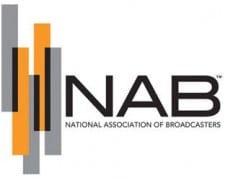 Here’s an ex parte filing with the FCC from the NAB commenting on DOJ’s recent submission regarding broadcasters’ joint sales and shared services agreements. NAB’s filing notes that DOJ did not provide any evidence that JSAs harmed consumers or the public interest or provided a cost-benefit analysis of its proposed rules change:
Here’s an ex parte filing with the FCC from the NAB commenting on DOJ’s recent submission regarding broadcasters’ joint sales and shared services agreements. NAB’s filing notes that DOJ did not provide any evidence that JSAs harmed consumers or the public interest or provided a cost-benefit analysis of its proposed rules change:
Before the
Federal Communications Commission
Washington, D.C. 20554
In the Matter of
2010 Quadrennial Regulatory Review – Review of the Commission’s Broadcast Ownership Rules and Other Rules Adopted Pursuant to Section 202 of the Telecommunications Act of 1996
Promoting Diversification of Ownership in the Broadcasting Services
Rules and Policies Concerning Attribution of Joint Sales Agreements in Local Television Markets
MB Docket No. 09-182
MB Docket No. 07-294
MB Docket No. 04-256
Ex Parte Submission of the National Association of Broadcasters
Joshua H. Soven
Gibson, Dunn & Crutcher LLP
1050 Connecticut Avenue, NW
Washington, DC 20036
(202) 955-8503
Jane E. Mago
Jerianne Timmerman
NATIONAL ASSOCIATION OF BROADCASTERS
1771 N Street, NW
Washington, DC 20036
(202) 429-5430
The National Association of Broadcasters (“NAB”) submits this comment in response to the February 20, 2014 ex parte submission by the Antitrust Division of the U.S. Department of Justice (the “Department”) in connection with the potential revision of the ownership attribution rules as they relate to television joint sales agreements (“JSAs”). Without providing any (1) direct evidence that the long-standing ownership attribution rule for television JSAs negatively affects consumers or the public interest or (2) cost-benefit analysis of its proposed rule change, the Department nonetheless urges the Commission to change established Commission policy and adopt a bright-line rule that would “treat any two stations participating in a JSA (or agreement similar in substance to a JSA) as under common ownership.” The Department’s reasoning is flawed, and its proposal would harm consumers and the public interest.
First, and critically, the Department does not dispute that limiting the number of JSAs would reduce the amount and diversity of television stations and content available to consumers. As NAB has explained in detail previously, JSAs have become vital to local station operations because television broadcasting generally and local news production specifically are subject to substantial economies of both scale and scope.3 Scale economies arise from the need for large capital investments in broadcasting equipment, production facilities, and spectrum licenses, and from the “first copy” property generally associated with intellectual property (e.g., the fact that the “first copy” of a news or entertainment program is expensive to produce, but distribution to additional users is essentially costless). Economies of scope arise from the use of assets to create multiple products (e.g., a single transmitter and antenna tower can broadcast multiple digital video streams over a single six MHz television channel; a single reporter can be assigned to cover a story for both the nightly news and the TV station’s web page).
The Department does not dispute that these economies of scale and scope allow broadcasters to:
–develop a wide range of informational and other public interest programming, including increased local news;
–offer consumers more diverse content, including programming serving niche audiences; and
–make capital investments, such as the purchase of high-definition equipment, needed to survive in a highly competitive sector.
Also significantly, the Department does not contest that the economies of scope and scale achieved by JSAs are essential to maintaining a diverse ownership of broadcast stations. To the contrary, the Department expressly disclaims any expertise with regard to these important policy objectives.
What the Department plainly wants is for the Commission to prioritize the narrow focus of the antitrust laws (in this case, to benefit large corporate advertisers and cable companies) and deemphasize the Commission’s broader charge to protect the public interest. And the Department is overtly aware that its advice is in tension with core Commission policies and responsibilities. In its submission, the Department explains that it “recognizes that the Commission’s ownership rules are also motivated in part by the need to promote localism and diversity, and that those concerns may call for somewhat different analysis” than the approach the Department favors. On this point, the Department is correct – its proposed rule change would reduce the Commission’s ability to fulfill central components of its mission.
The Commission has of course long recognized that protecting the public interest, including promoting localism and ensuring access to a diverse range of programming, often requires the Commission to adopt different approaches to transactions, station ownership and related issues than those favored by antitrust enforcers. In fact, the Commission has emphasized that its analysis “under the public interest standard” is broader than the Department’s review, which “is limited solely to an examination of the competitive effects of [an] acquisition, without reference to diversity, localism, or other public interest considerations.”6
The conflict between the Commission’s mission to protect the “public interest” and the Department’s proposed alternative course should by itself warrant rejection of the Department’s recommendations. However, the Department’s analysis is also flawed within the more limited framework of the antitrust laws. In contravention of the Department’s own policy statements, including its Horizontal Merger Guidelines, the Department’s submission relies on generalizations about the structure of JSAs, not actual evidence of consumer harm. In urging the Commission to adopt a blanket rule for the treatment of JSAs with respect to ownership attribution, the Department avoids whole categories of evidence that it relies on in its investigations. For example, the Department barely acknowledges the wide range of broadcaster participants in JSAs, the significant differences in station economics between large and small television markets, the number of competing broadcasters that JSAs face, and the procompetitive benefits JSAs provide.
The Department’s policy recommendations – even more problematically – are based entirely on the false and dated assumption that local broadcasting is a relevant antitrust product market. If the Department acknowledged that broadcast television stations face a host of non-broadcast competitors (as they plainly do), it would dismantle the Department’s rationale for its proposed rule change. The simple fact is that in asserting rather than demonstrating the existence of a local broadcast television relevant product market, the Department looks backwards at past market structures rather than forwards at the robust and rapidly changing competitive landscape. Missing from the Department’s submission is any contemporary empirical evidence to support a local television broadcasting product market. In place of such evidence, the Department can only cite its own pleadings – including pleadings from 1996, 2000, and 2003 – in settled merger cases, which themselves only contain conclusory general assertions. In relying on these old pleadings, the Department simply ignores that the competitive landscape facing local television stations has changed dramatically in the last ten years.
As NAB has demonstrated to the Commission, local TV stations today fiercely compete with cable and other multichannel video programming distributors (“MVPDs”) for audience share and advertising dollars, both local and national.8 According to Bond & Pecaro, cable providers earned over $1.7 billion in local ad revenues in the Top 10 Nielsen Designated Market Areas (“DMAs”) in 2012.9 That is the equivalent of having more than three additional broadcast television stations in each of the Top 10 markets, based on BIA’s 2012 average station ad revenues in those markets. In DMAs ranked 11-25, local cable’s ad revenues are the equivalent of having more than two additional broadcast TV stations in each of those markets, and nearly two additional local TV stations in markets 26-50.10
The intensity of competition from cable, satellite and telcos has been strengthened even more through the stepped-up use of “interconnects” in recent years. These interconnects are combined platforms of multiple cable operators, satellite providers, and telephone companies. They allow advertisers to purchase local advertising in many markets and on many channels from multiple MVPDs through a single contract. For example, NCC Media (which itself is owned by large cable operators) has reported that “alliances” have been formed between “NCC, cable operators and satellite and telco programming distributors, including DIRECTV, AT&T U-verse and VERIZON FiOS.”
And this past August, NCC Media announced that it and DISH had “join[ed] forces,” stating that this “arrangement crowns a decade-long effort by NCC and its [cable] owners to consolidate the advertising reach of all US MVPDs” for national and local television advertisers.
The Department also ignores that broadcast stations face substantial competition from online/digital advertising, which have reduced broadcasters’ revenues as advertisers allocate more of their budgets to locally targeted digital, mobile and social media advertisements. BIA/Kelsey projects that online/digital advertising revenues will increase at 13.8 percent compound annual growth rate (CAGR) from 2013-2017, rising from $26.5 billion to $44.5 billion. Location targeted mobile ad revenues are growing at a faster pace than overall mobile advertising and will increase from $2.9 billion in 2013 to $10.8 billion in 2017. In contrast, traditional advertising revenues are projected to grow only slightly over the same time period, with a CAGR of 0.1 percent from 2013-2017.
SNL Kagan’s recent examination of the advertising marketplace further illustrates the substantial changes that have diminished broadcasters’ competitive position and reduced their economic viability. Looking at local advertising revenue specifically, SNL Kagan found that Internet and cable TV advertising grew at a CAGR of 24.7 and 4.8 percent, respectively, from 2003-2012. Broadcast TV advertising revenue, by contrast, had a negative CAGR (0.1 percent) over that same time period. From 2013-2022, SNL Kagan projects that local Internet, cable TV, mobile and telco advertising revenue will grow at a CAGR of 4.3 percent, 5.5 percent, 22.5 percent, and 21.6 percent, respectively, with broadcast TV local ad revenue growing at a CAGR of 2.7 percent.
Largely as a result of marketplace fragmentation and the growing numbers of options for advertisers (including online), television broadcasters’ revenues and profits have fallen significantly. SNL Kagan reports that broadcast television stations’ advertising revenues fell precipitously after 2006 and, despite rebounding to a degree after the recession, remained at lower levels in 2012 than in 2004.17 Indeed, SNL Kagan projects that broadcast television station advertising revenues will not reach the level of revenues earned in 2004 until the year 2020.18 These data speak to a durable long-term shift in television stations’ competitive environment. The Department’s reliance on filings and pleadings from the 1990s, and even the 2000s, is untenable in light of evidence that entire advertising platforms, such as online and mobile, were nascent or did not exist in those years but are now strong and growing competitors in the advertising marketplace.
The bottom line is that the Department’s entire submission hinges on the false and implausible premise that “Advertising on local broadcast stations has no close substitutes.”21 In fact, as shown, JSAs (and other similar arrangements) do not and cannot allow broadcast television stations to exercise pricing power because they face intense competition from cable, satellite, Internet, and online providers, all of whom aggressively compete on content development and advertising sales. And in clinging to its narrow twentieth-century market definition, the Department ignores one of the few facts that it includes in its submission – a majority of Americans get their television content from sources other than free, over-the-air television broadcasts.
Finally, and fundamentally, it is important to recognize that the Department’s submission is an effort to alter how the Commission fulfills its obligation to protect the public interest, an obligation for which the Department has no responsibility. The Department is clear that its proposed changes to the JSA rules have nothing to do with antitrust enforcement, stating that it will continue to challenge JSAs regardless of whether the Commission changes its ownership rules.23 Thus, while the Department frames its submission as an attempt to further a common Commission/Department objective to protect “competition,” its clear purpose is to advance the limited focus of antitrust enforcement at the expense of the broader public interest the Commission is charged to protect.
In summary, the Commission’s ownership attribution rules with respect to JSAs have for years benefitted consumers and promoted localism by increasing broadcast programming, especially local news, supporting the development of diverse and niche programming, and encouraging technological investment. The Department’s proposed policies would put these benefits at substantial risk.
Joshua H. Soven
Gibson, Dunn & Crutcher LLP
1050 Connecticut Avenue, NW
Washington, DC 20036
(202) 955-8503
Respectfully submitted,
___________________________
Jane E. Mago
Jerianne Timmerman
NATIONAL ASSOCIATION OF BROADCASTERS
1771 N Street, NW
Washington, DC 20036
(202) 429-5430
March 18, 2014
RBR-TVBR observation: Are we the only ones wondering why the Justice Department is obsessing over the alleged market power of two local TV stations in Anytown, USA when there’s an elephant in the room in the form of Comcast buying Time Warner Cable? Market power is the clustered cable industry carving up regions of the company so they don’t have to compete. Market power is the No. 1 cable company (Comcast) buying the No. 2 cable company (Time Warner.)
Note to Mr. Justice Department lawyers: A combined Comcast/TW Cable will mean 30 MILLION pay TV subscribers, all under one roof. And you’re worried about one TV station selling advertising for another in Boise or Bangor. Really?





